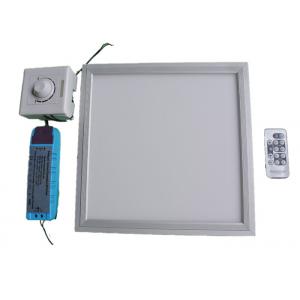

Add to Cart
TRIAC dimmable led panel 40W 600x600m led panel light IP44 rating 4000K
Specifications of Dimmable led panel
Technical parameters:
Model | Optical efficiency | Power | CCT Range | Color Temperature | Flux(lm) | Net weight |
ZLP060640WD | 80-85LM/W | 40W | 2800-6500K | White | >3500LM | 4.3Kg |
General Parameters:
Dimming Type | Input voltage | Size | LED type | Uniformity | Frequency | Working temperature |
TRIAC Dimming | AC100-240V | 595×595×10mm | smd 2835 | 90-95% | 50-60HZ | -20-+50°C |
Features of Dimmable led panel
1. Light distribution design: front light, high brightness, mixed evenly.
2. waterproof, Prevent lampblack, dustproof, anti-mosquito
3. Luminance decrease control No more than 3% control: 2000 hours
4. LED selection:SMD 2835 Hight lumens.
5. Driven design: adopting the designed with high efficiency constant current drive power supply.
6. Product quality: all products before they leave the factory after several strict
7. Pure white.warm white , cool white ,Red,Green Bule, Yellow,and RGB available.
8.200*200mm,300*300mm,300*600mm,300*1200mm,600*600mm,600*1200mm available.
9.Energy saving, Environmental friendly
10.Light and Soft, no electric wave,no RF interference.
11. Can be dimming
12.Long service life over 50000 hours
Our advantages of Dimmable led panel
Intruduction about TRIAC DIMMING PANE LIGHT
TRIAC Dimming LED Light panel
TRIAC, from Triode for Alternating Current, is a genericized tradename for an electronic component that can conduct current in either direction when it is triggered (turned on), and is formally called a bidirectional triode thyristor or bilateral triode thyristor.
TRIACs belong to the thyristor family and are closely related to
Silicon-controlled rectifiers (SCR). However, unlike SCRs, which
are unidirectional devices (i.e. can conduct current only in one
direction), TRIACs are bidirectional and so current can flow
through them in either direction. Another difference from SCRs is
that TRIACs can be triggered by either a positive or a negative
current applied to its gate electrode, whereas SCRs can be
triggered only by currents going into the gate. In order to create
a triggering current, a positive or negative voltage has to be
applied to the gate with respect to the A1 terminal (otherwise
known as MT1).
Once triggered, the device continues to conduct until the current
drops below a certain threshold, called the holding current.
The bidirectionality makes TRIAC very convenient switches for AC
circuits, also allowing them to control very large power flows with
milliampere-scale gate currents. In addition, applying a trigger
pulse at a controlled phase angle in an AC cycle allows one to
control the percentage of current that flows through the TRIAC to
the load (phase control), which is commonly used, for example, in
controlling the speed of low-power induction motors, in dimming
lamps and in controlling AC heating resistors.
